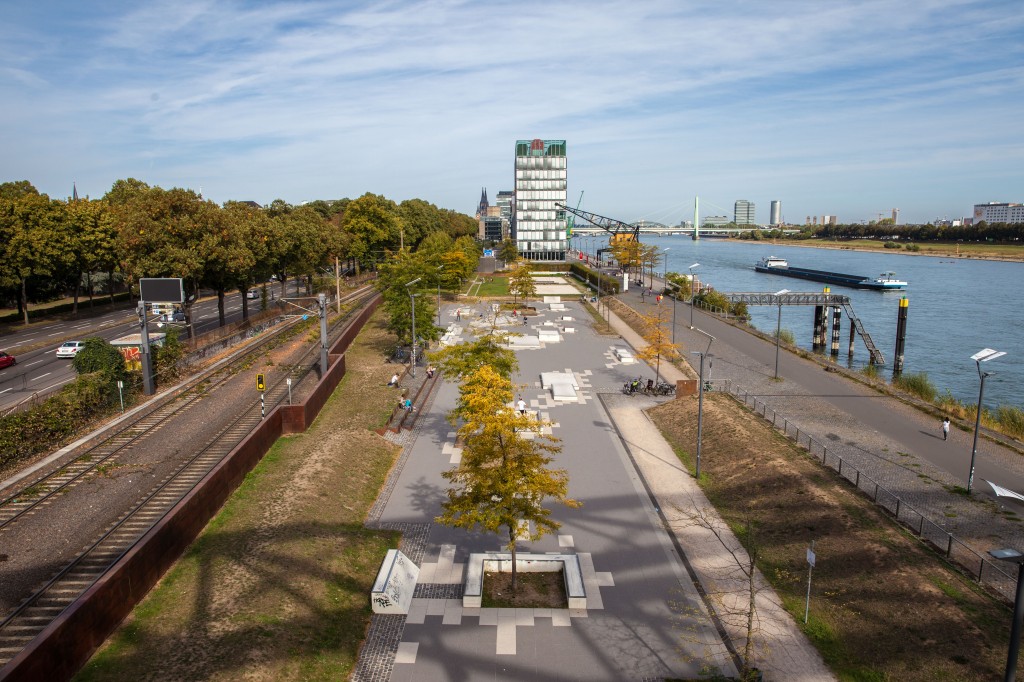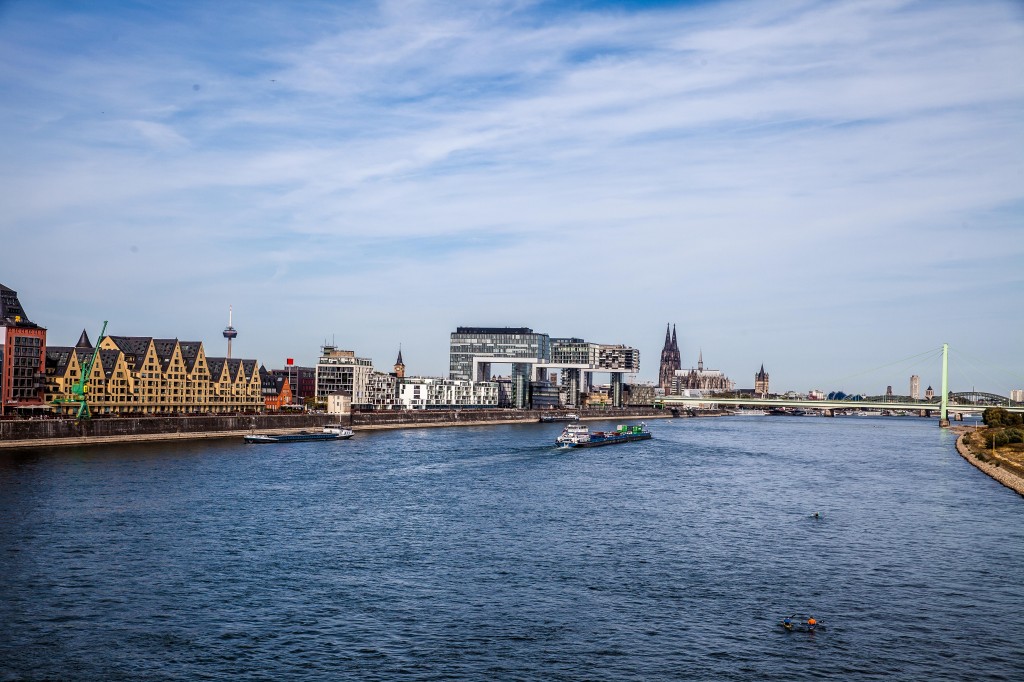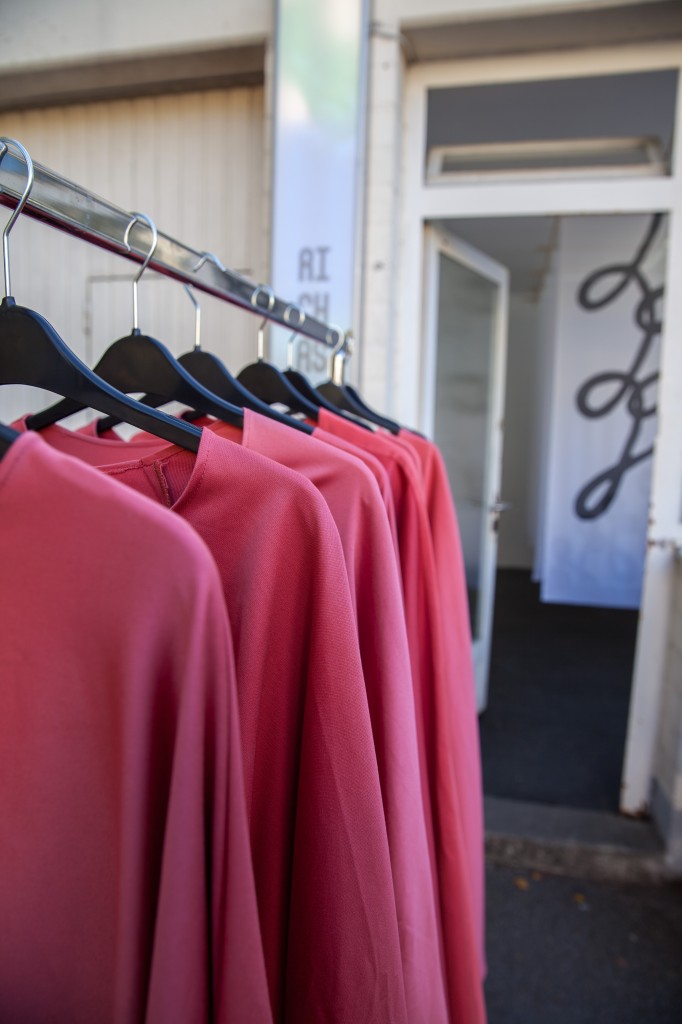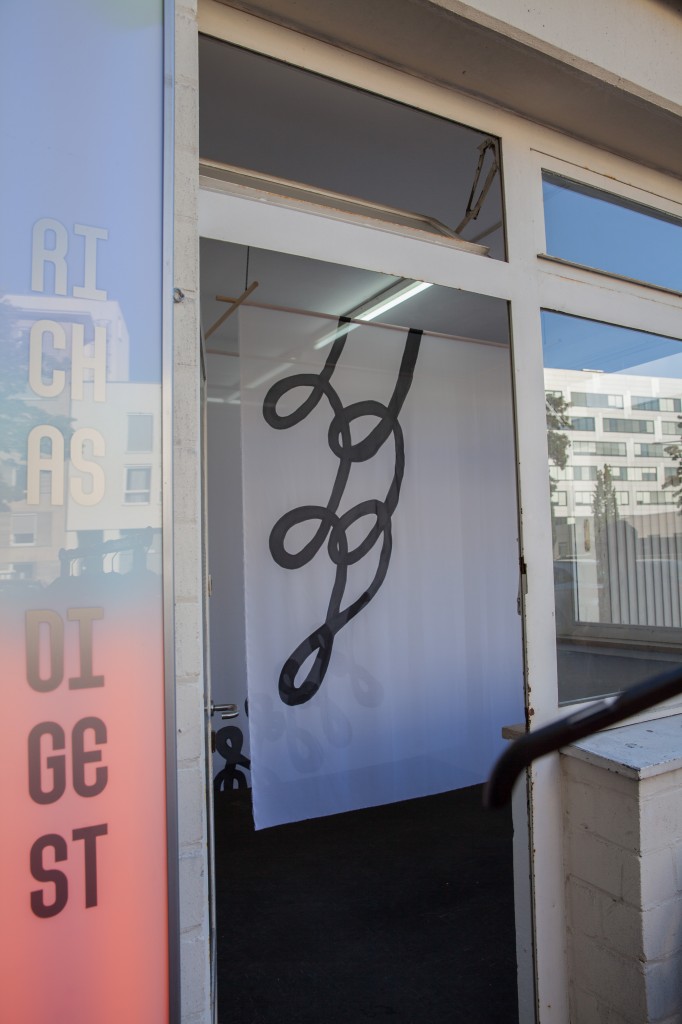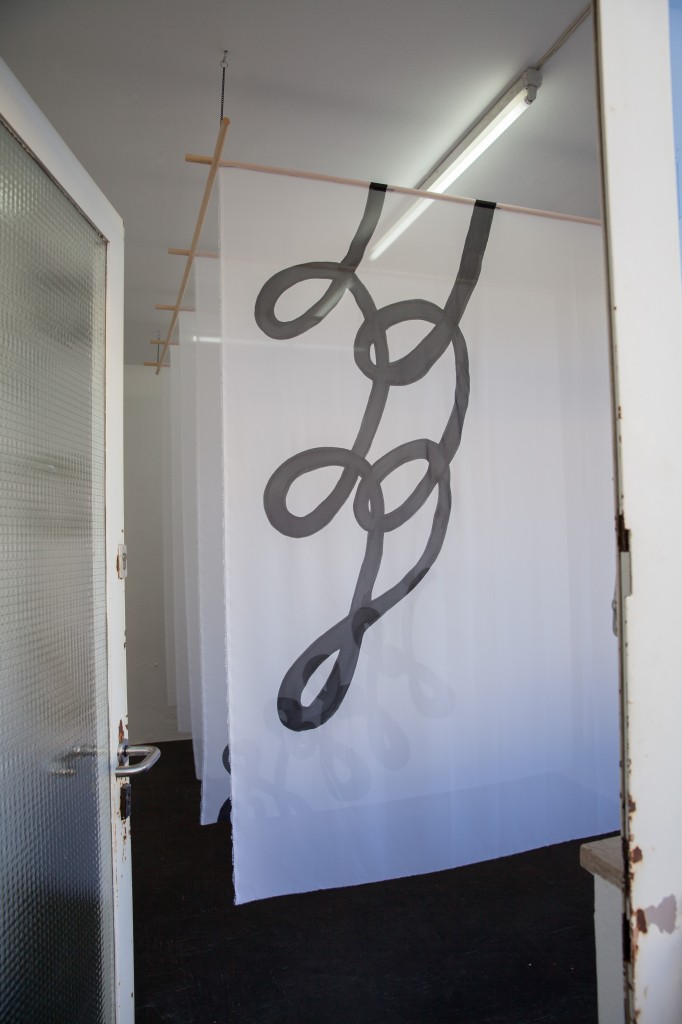I didn’t meet my buddy, because he’s in Brazil, but I did attend the International Center of Technische Hochschule Köln’s KARIBU buddy potluck on Friday! The room was packed and the tables were full of food from all regions of the world. The idea was to bring something you would find on your table in your home country. So, what did a couple of students from the U.S. bring? Peanut Butter and Jelly. A classic.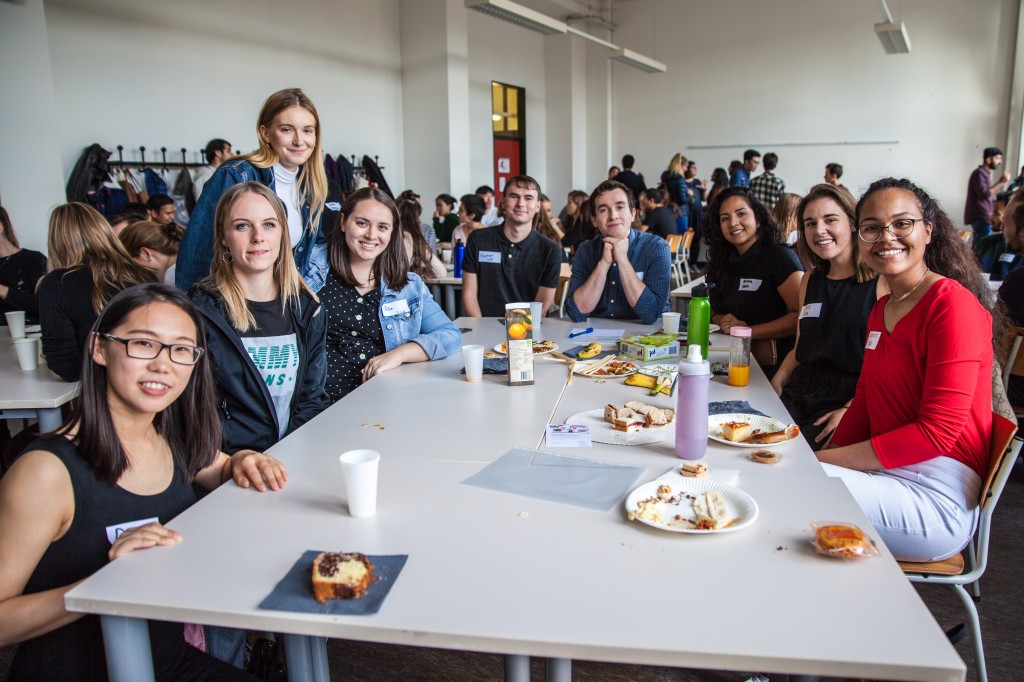
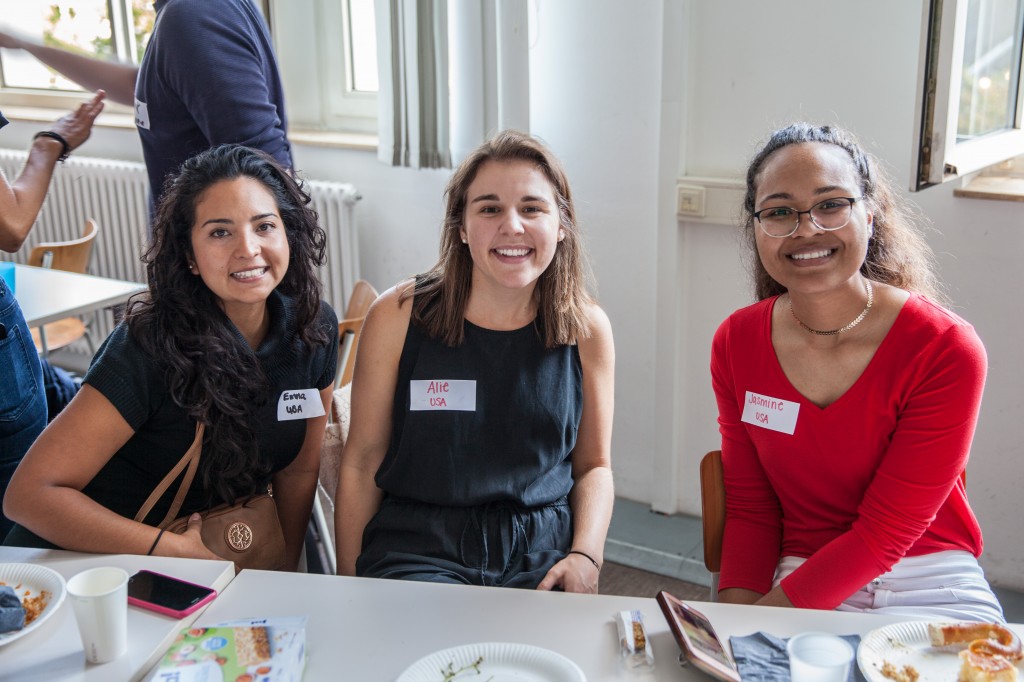
Category Archives: Europe
The Last Day of Summer
It has been raining everyday since last Sunday, September 22, 2019. So long, summer.
Luckily, I was told about the waterfront on the other side of the river (in the area called Poll, though I’ve heard locals refer to it as Kalk, which is technically a further inland area according to Google Maps), that has parks, grass, trees, football fields, and even a beach with real sand.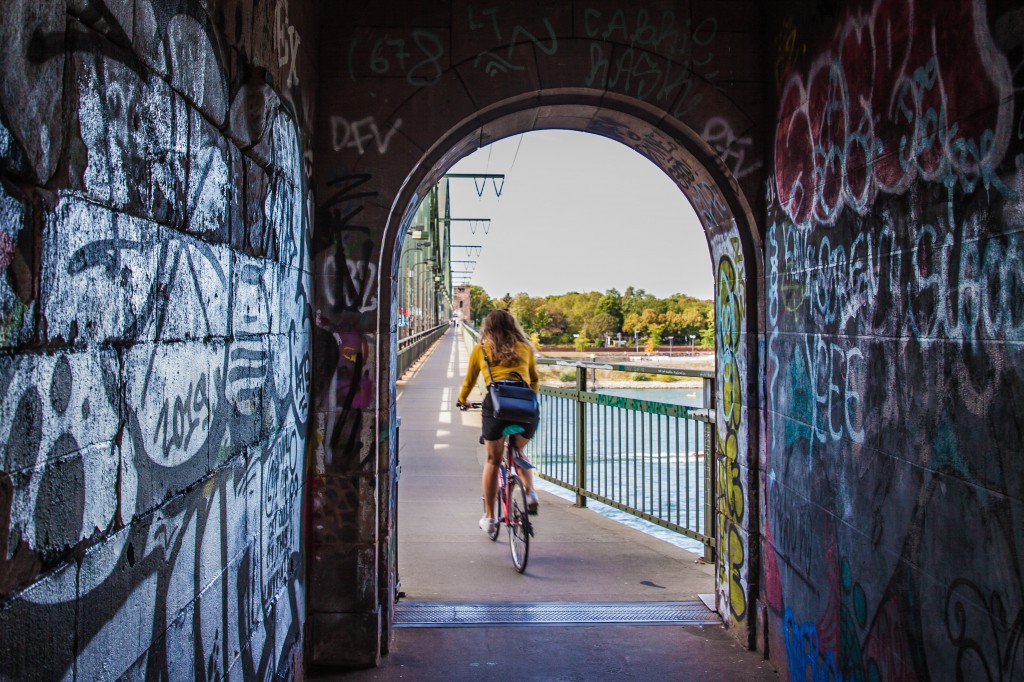 So the day before the gray set in, my peers and I, fresh to Cologne, set out to the Southeast of the Inner City to a walking bridge that leads to the other side.
So the day before the gray set in, my peers and I, fresh to Cologne, set out to the Southeast of the Inner City to a walking bridge that leads to the other side.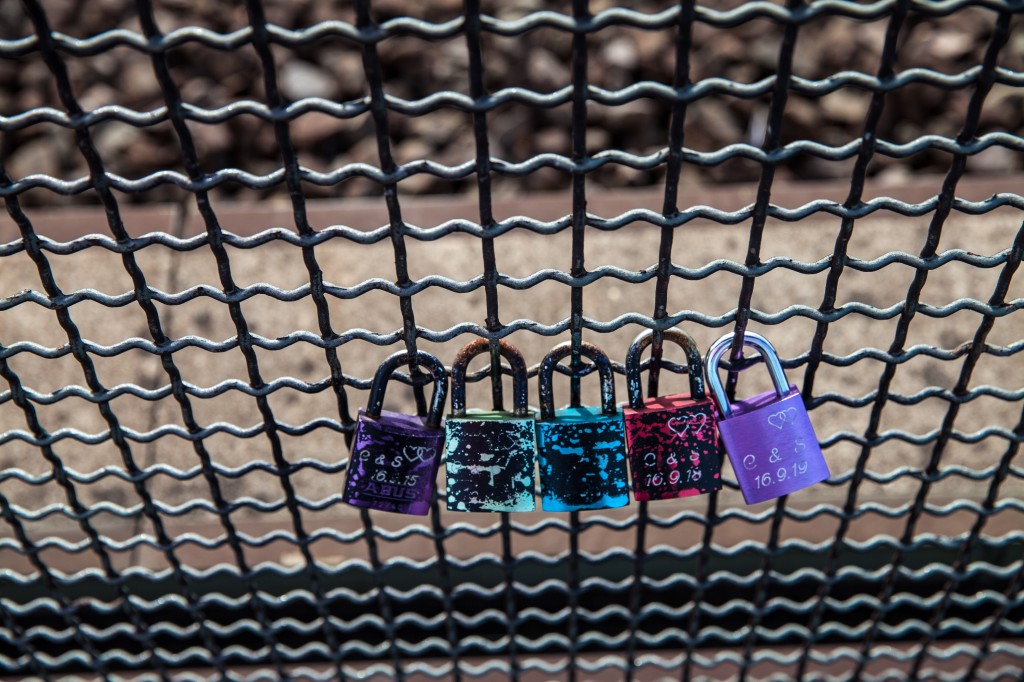 Watching out for geese droppings, we laid our yoga mats out in the sun at the corner of an out-of-play football field and relaxed with stretching and yoga.
Watching out for geese droppings, we laid our yoga mats out in the sun at the corner of an out-of-play football field and relaxed with stretching and yoga.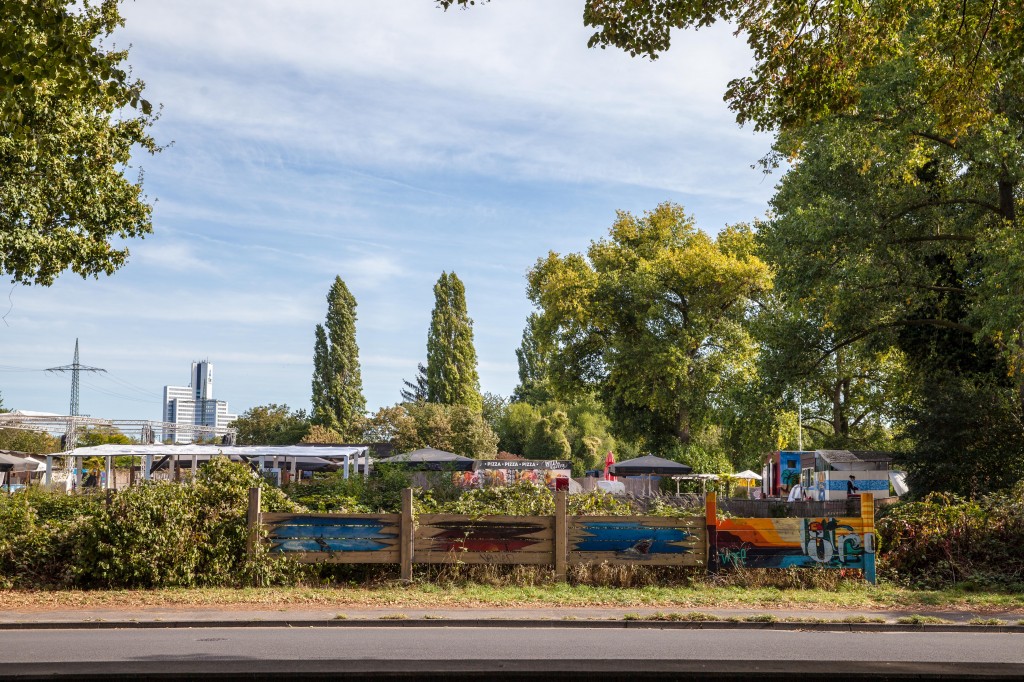 Then we walked further South and dipped our feet in the cold, cold Rhine, played games and absorbed as much of the last rays of sunshine as the sun would allow.
Then we walked further South and dipped our feet in the cold, cold Rhine, played games and absorbed as much of the last rays of sunshine as the sun would allow. 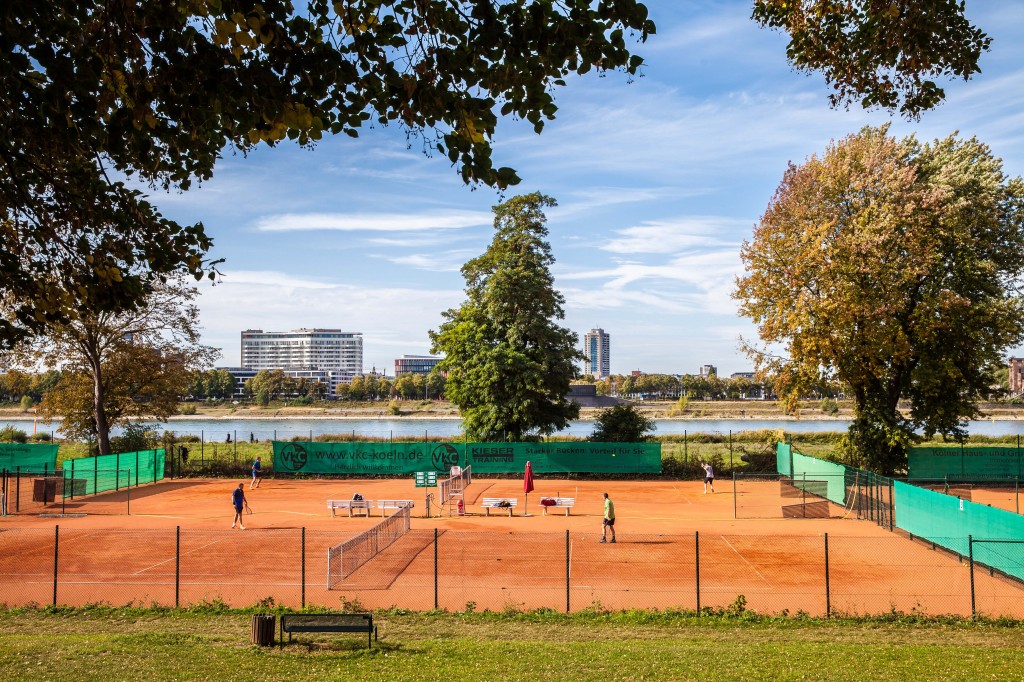
Into the Current at Richas Digest
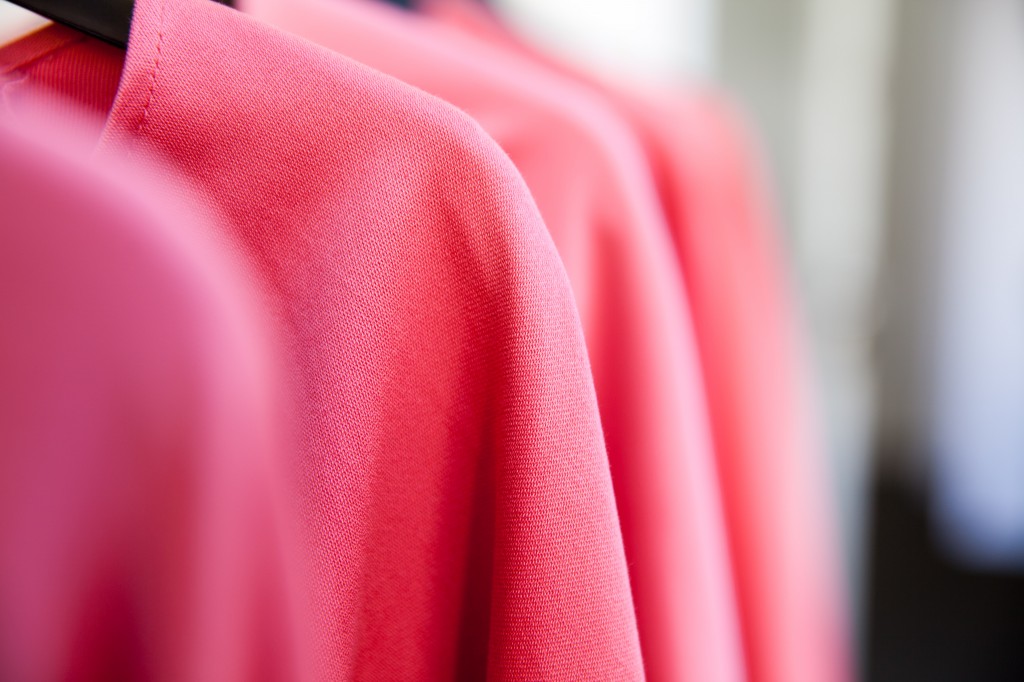 I stopped into Richas Digest, an art space in Cologne for the last day of “Into the Current.” On a rack outside, held a beautiful pink color, which were cloaks. I donned one and stepped inside.
I stopped into Richas Digest, an art space in Cologne for the last day of “Into the Current.” On a rack outside, held a beautiful pink color, which were cloaks. I donned one and stepped inside.
The swirls, the movements of paint, and the fabric it was on reminded me of dancing. As I walked by, the sheer fabric with it’s paint felt the air going by and it showed by not staying still.
I walked around, and suddenly the direction the paint was going was the course of my life, and it was up and up. But, when I looked back through the fabric from the other side I did not like what I saw. The shapes were not as they had been, and frightened me.
I walked the other way, and I zig-zagged, with the white sheets with black paint forming different images from each angle, and I decided the only way to walk through was the way I had first gone.
INTO THE CURRENT
FRIEDERIKE HAUG and MARTHA HVIID
Severinstraße Fair: a street party
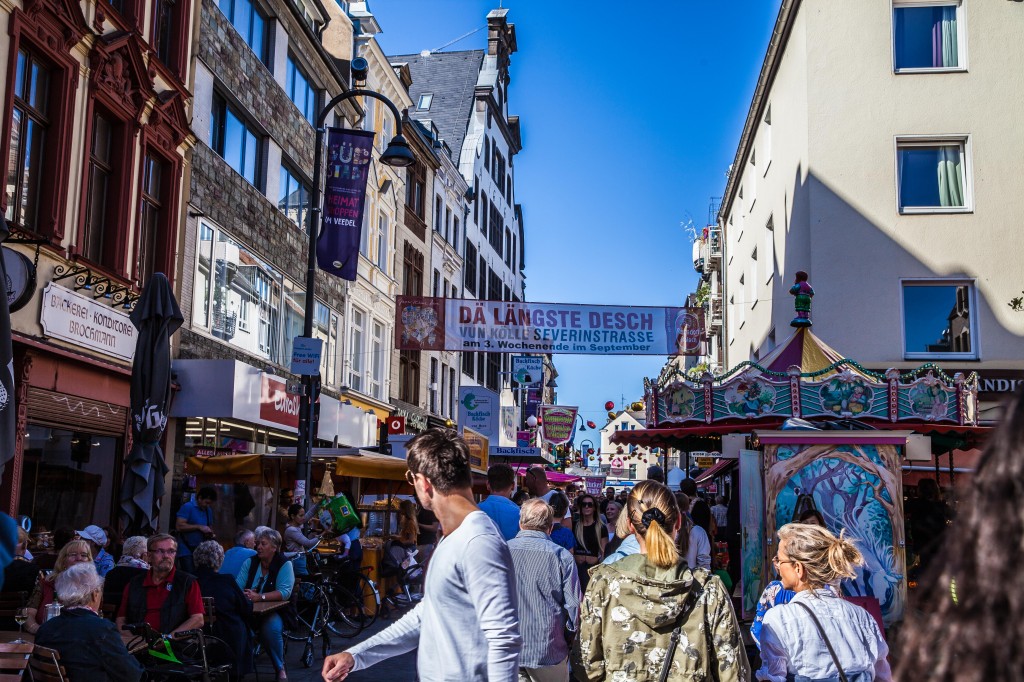 Delicious fried fish, endless Kölsch, a variety of wares from clothes to wooden spoons, and even a pianist street musician filled Severinstraße with color and celebration on the third weekend in September.
Delicious fried fish, endless Kölsch, a variety of wares from clothes to wooden spoons, and even a pianist street musician filled Severinstraße with color and celebration on the third weekend in September.
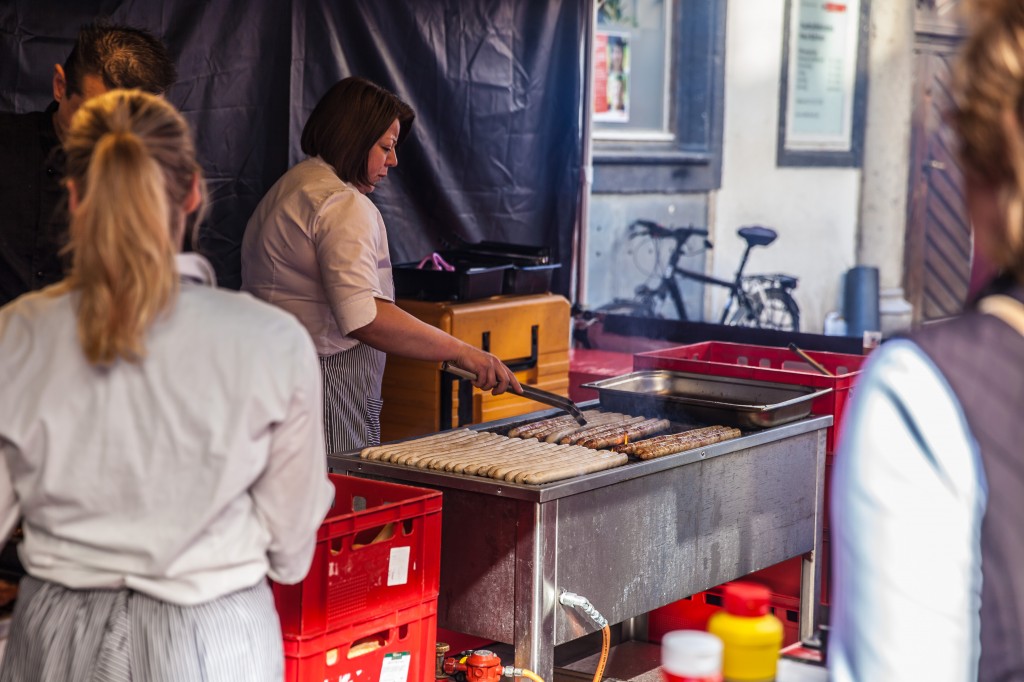 I had happened to be in town for the 40th annual Severinstraße Fair, or “Dä Längste Desch, vun Köll Severinstraße.” By day was great, but by night was awesome.
I had happened to be in town for the 40th annual Severinstraße Fair, or “Dä Längste Desch, vun Köll Severinstraße.” By day was great, but by night was awesome.
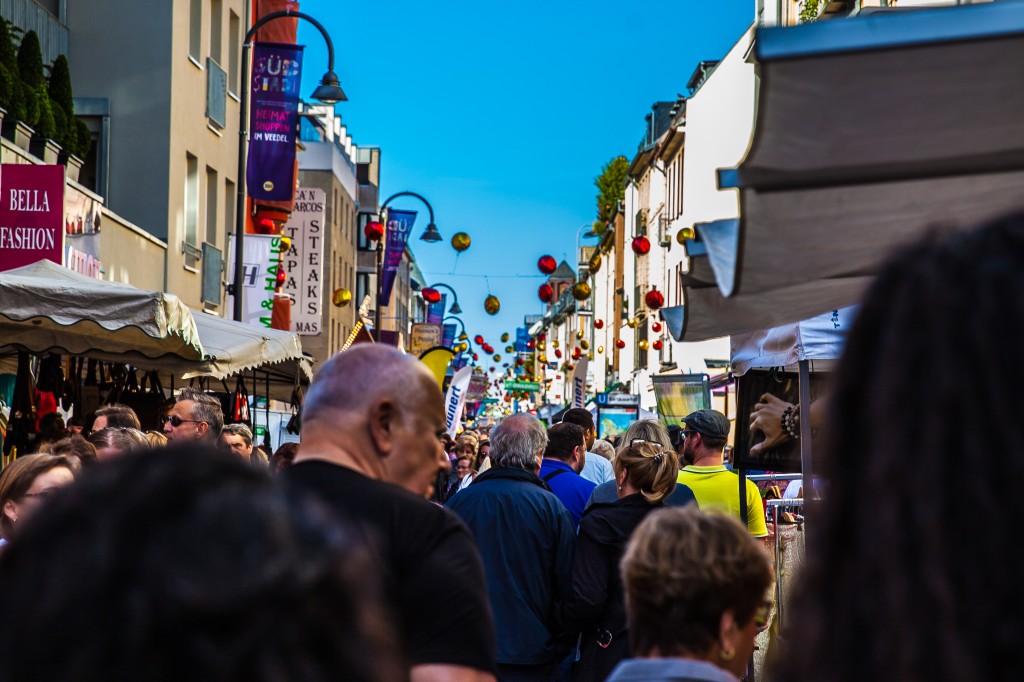 If you also happen to be in Cologne that time of year, I recommend experiencing it!
If you also happen to be in Cologne that time of year, I recommend experiencing it!
Walking tour of Cologne
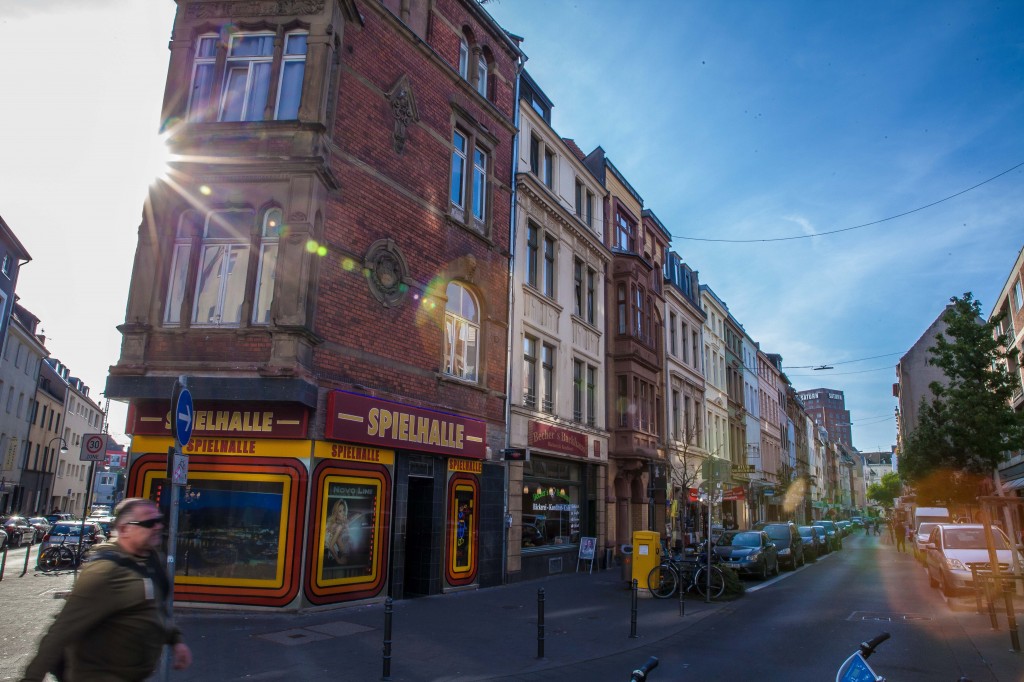
The photo above represents the architecture before World War II. Across the street, the buildings look much more modern.
I went on a walking tour of Cologne with FreeWalk Cologne at 16:11. Our tour guide was Kristina, and I learned all sorts of historical tidbits about the city from her. (Don’t worry, you will still learn a ton if you do one yourself! Psst…Kristina, if I got anything wrong just let me know, okay? Edit: Kristina has reviewed! Thanks, Kristina!) For instance, there were once 12 medieval gates surrounding the city and three are still standing, including the one that the seal pictured below was on. The three crowns represent the Three Kings, or wise men, who brought the three gifts of gold, frankincense and myrrh on the day of Jesus’s birth. The remains of the Three Wisemen are kept in the Cologne Cathedral, which was constructed specifically for this purpose.
I learned of Agrippina, the mother of Nero, and how Cologne girls are said to “have pepper in their butt.” Which means, they get what they want. Agrippina wanted to marry her uncle Claudius, the emperor of Rome. So, they married in 49 A.D. Agrippina also wanted the name of the town she was born in to become a Roman colony. And hence, “Colonia Claudia Ara Agrippinensium” was born, which was shortened to Colonia which morphed into “Cologne” and in German “Köln.”
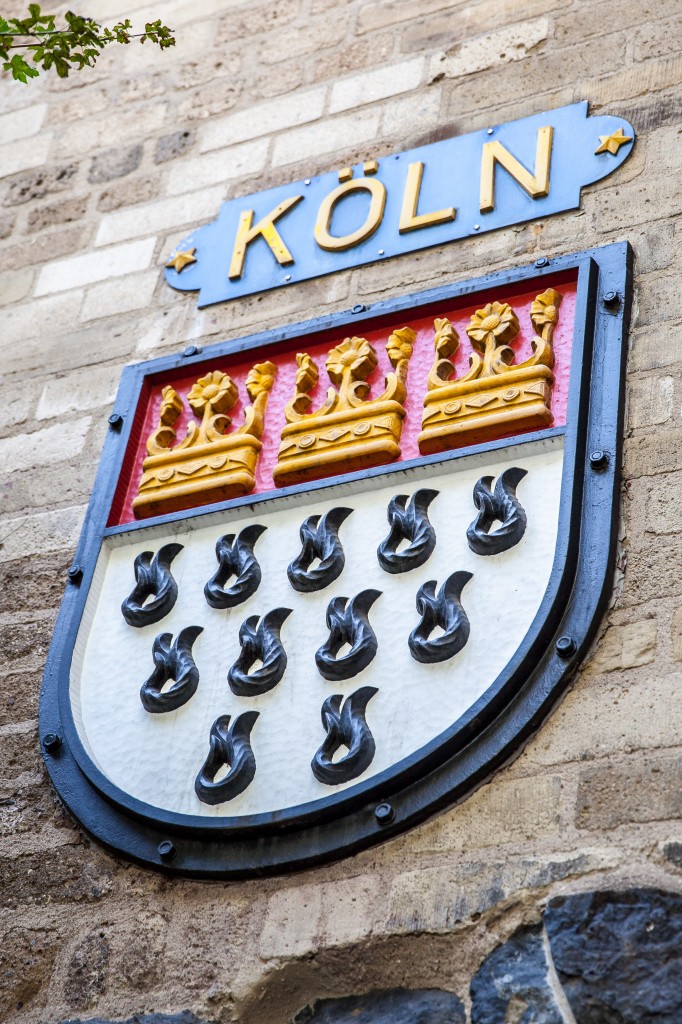
I learned of Ursula (who’s since been sainted) and how she was having what has come to be known as a bachelorette party with 11 virgin women (which has evolved to thousands in folklore), and decided to go have a chat with the Huns to try to convince them not to destroy Cologne. Well, the Huns leader thought the women were meant as a “gift,” and burned or drowned (hence the flame or droplets in the seal, though some accounts say beheaded) them all and left Cologne alone.
The red and white in the seal represent the colors of the city, and together they make pink! Cologne is full of heart, and is also home to the biggest gay community in Germany.
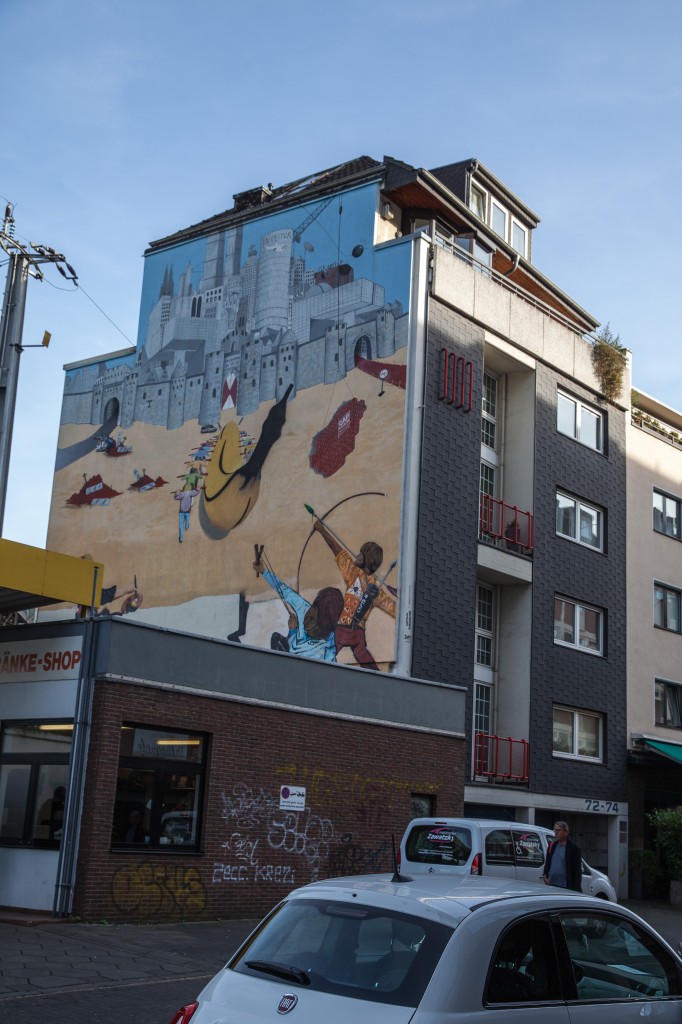 The street art above by Thomas Baumgärtel is supposed to symbolize conquering the city with a banana, and was crafted in protest of the local government and business’s attempt to drive the artists out of their former galleries and workshops.
The street art above by Thomas Baumgärtel is supposed to symbolize conquering the city with a banana, and was crafted in protest of the local government and business’s attempt to drive the artists out of their former galleries and workshops.
Because Cologne is SO proud of their Cathedral, and it is SO important in Cologne, it is its own sign of protest to picture the Cathedral in the background or as insignificant (as it is above).
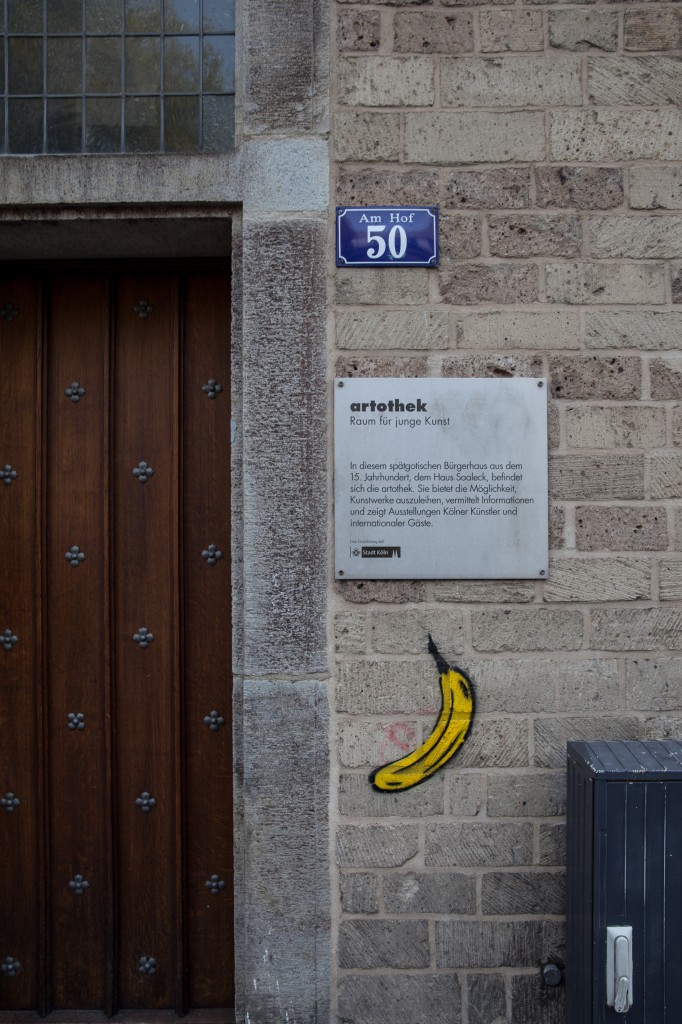 The banana has become a “stamp of approval” that the artist paints on the outside of art houses in Cologne.
The banana has become a “stamp of approval” that the artist paints on the outside of art houses in Cologne.
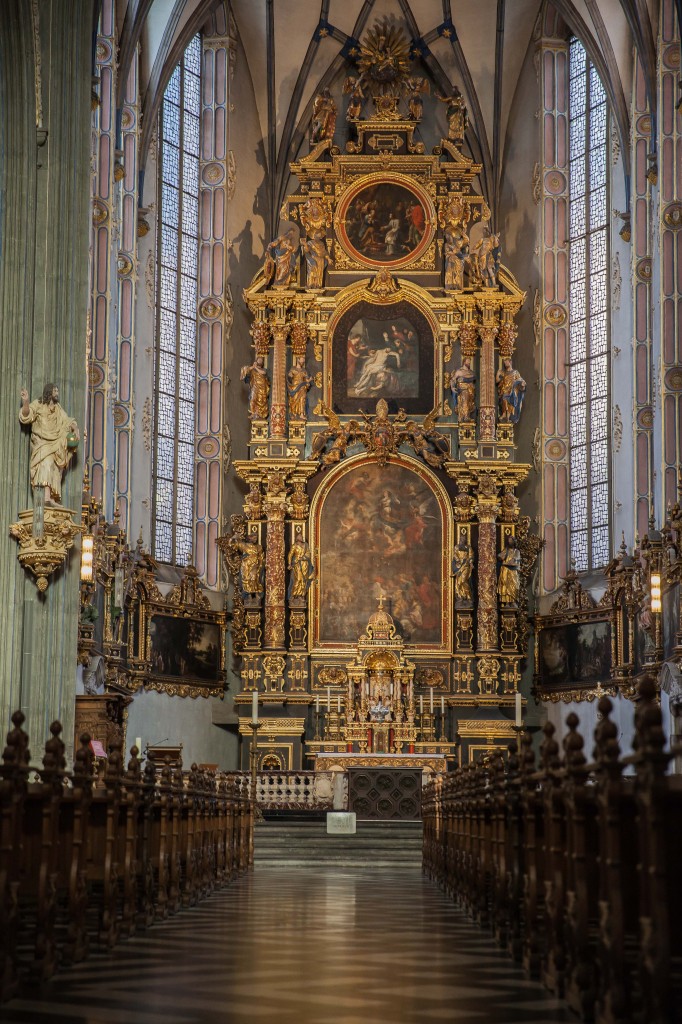 Above is the inside of a former Jesuit church in Cologne, now home to the Italian Catholic Community here, St. Mariä Himmelfahrt. This church, also featured below, is a block from the Cologne Cathedral.
Above is the inside of a former Jesuit church in Cologne, now home to the Italian Catholic Community here, St. Mariä Himmelfahrt. This church, also featured below, is a block from the Cologne Cathedral.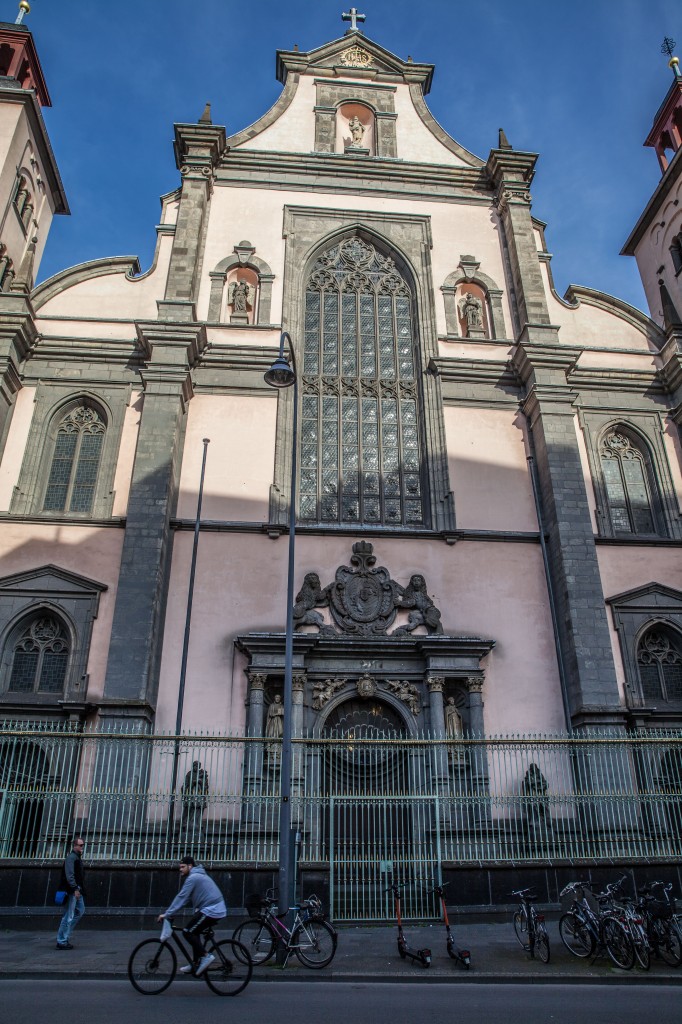
Cologne itself was hit 262 times by bombs, and 650,000 tons of bombs were dropped on the entire state of North-Rhine Westphalia during WWII, and some are still in the ground. When construction is happening in the city and one is found, the whole neighborhood must be evacuated. Not only bombs are found. The wall featured below was built around the year 50, while a parking garage was being built in the center of the city, right next to the Cathedral. The garage was built around it.
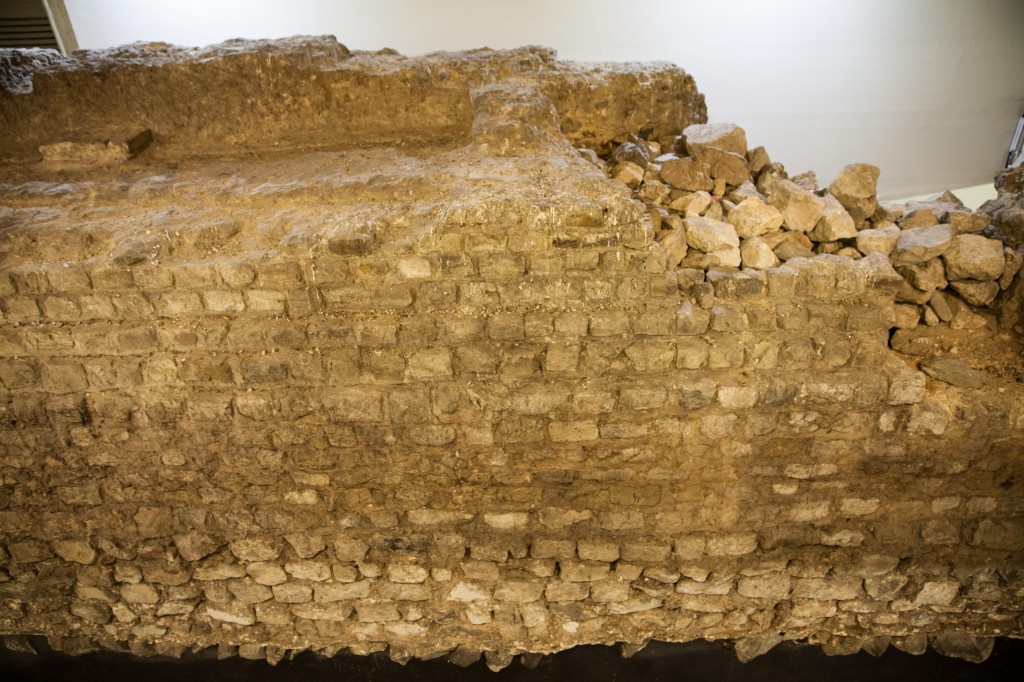 While the Cathedral was being built, the architects went off the rule “as above, so below,” as there were no precedents set for building a skyscraper in year 1248, so the foundation is huge. Fourteen aerial bombs hit the Cathedral (der Dom) during the war. Citizens of Cologne would run out at night with buckets to put the fires out. “Home is where the Dom is” is a common saying here, meaning that the people of Cologne feel a strong connection to the Cathedral.
While the Cathedral was being built, the architects went off the rule “as above, so below,” as there were no precedents set for building a skyscraper in year 1248, so the foundation is huge. Fourteen aerial bombs hit the Cathedral (der Dom) during the war. Citizens of Cologne would run out at night with buckets to put the fires out. “Home is where the Dom is” is a common saying here, meaning that the people of Cologne feel a strong connection to the Cathedral.
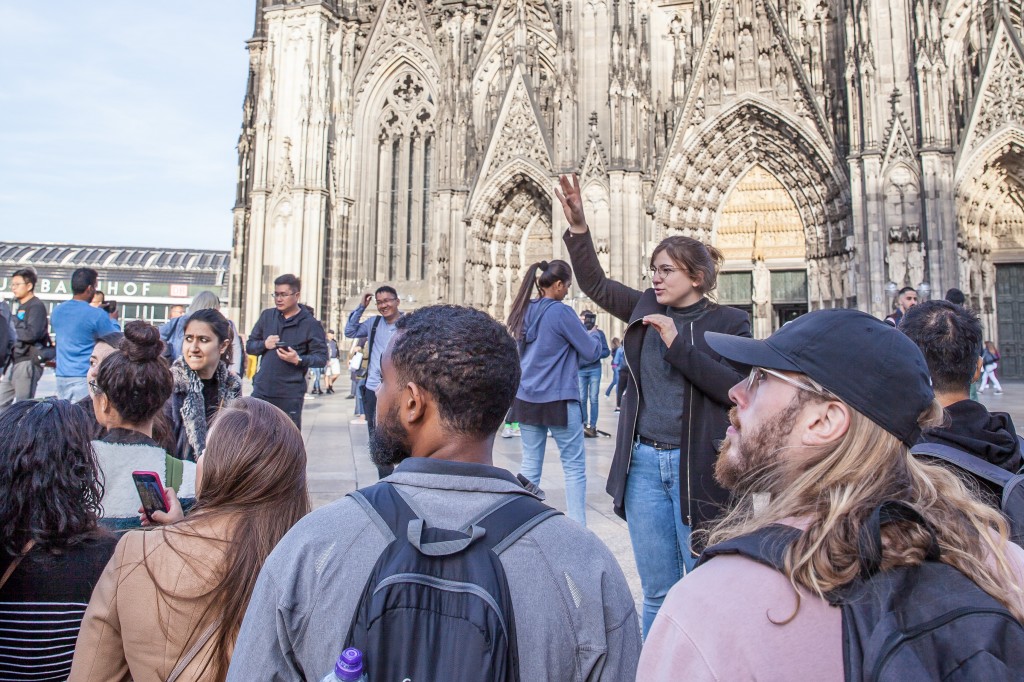 Construction was nowhere close to completion by the time Napoleon arrived. He thought it would be a great stable for his horses and ammunition. The Prussians offered to finish the Dom even though the Catholic Church had been working on on and off for 500 years… Nowadays, there is always scaffolding, so, it is essentially under constant construction.
Construction was nowhere close to completion by the time Napoleon arrived. He thought it would be a great stable for his horses and ammunition. The Prussians offered to finish the Dom even though the Catholic Church had been working on on and off for 500 years… Nowadays, there is always scaffolding, so, it is essentially under constant construction.
Cologne has even added its own goat-gargoyle, which urban legend has it is “Hennes,” Cologne’s real-live goat football (-not American football, obviously-) mascot, as seen below.
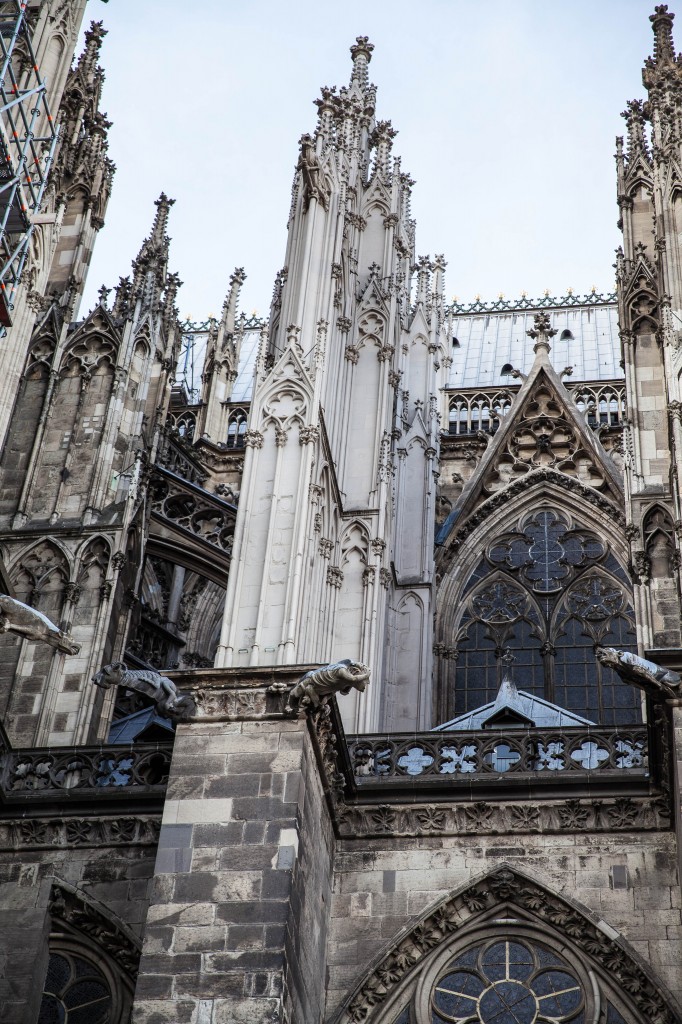 Pictured below is the old City Hall. Can you guess who up there suggested taxing alcohol?
Pictured below is the old City Hall. Can you guess who up there suggested taxing alcohol?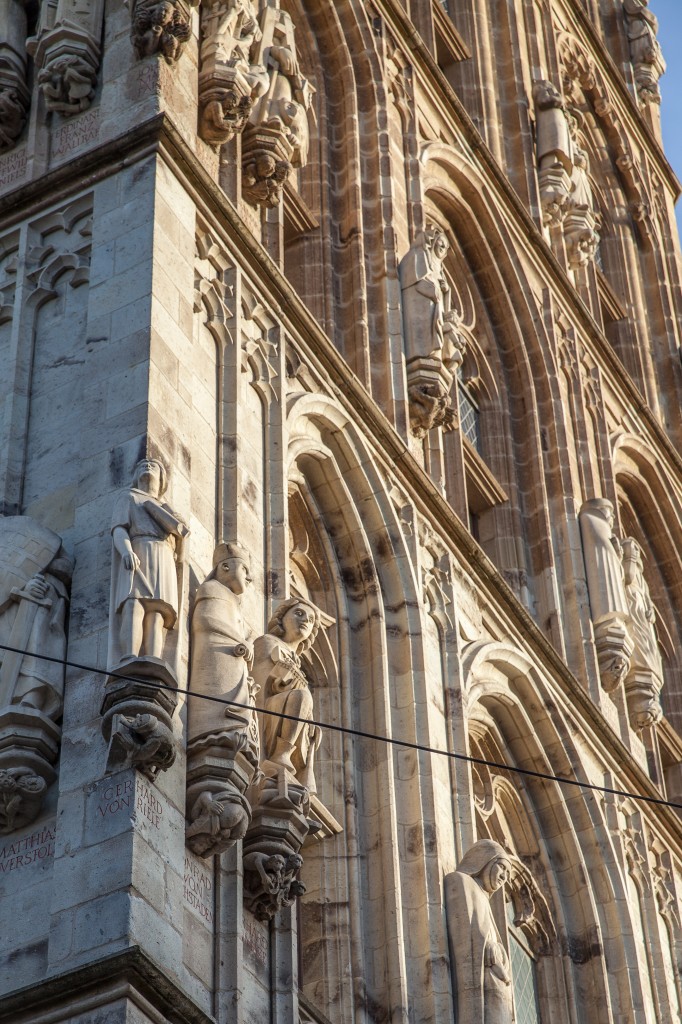 That’s all for my virtual tour! You’ll have to go on one yourself to find out why it started eleven minutes after the hour. Tschüss!
That’s all for my virtual tour! You’ll have to go on one yourself to find out why it started eleven minutes after the hour. Tschüss!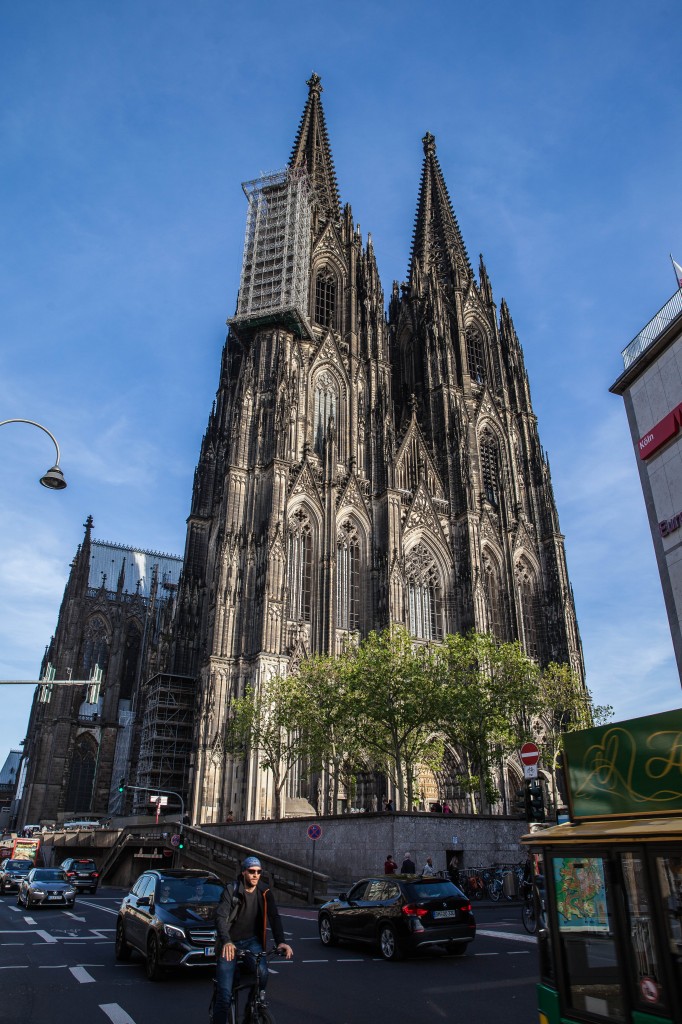
7 Instagram-Worthy Things To Do in Cologne
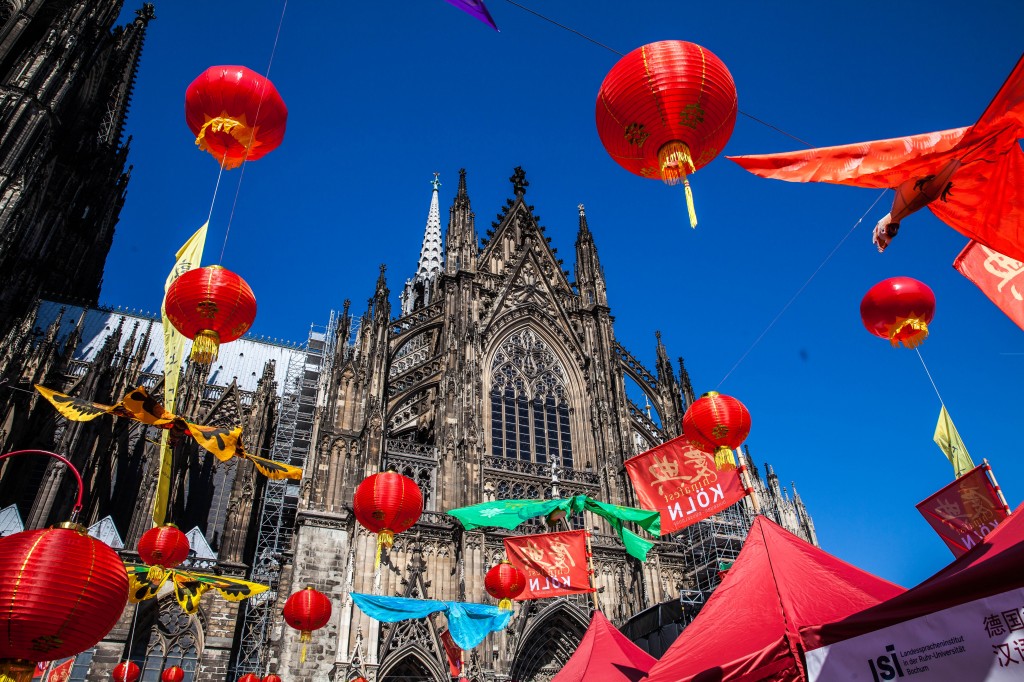 1. Festivities. What makes the time you’re there special? I arrived in the midst of Cologne’s fourth annual Chinese Festival, which took place right outside the Cologne Cathedral. The Cathedral, it so happens, is right next to the Hauptbahnhof where I first arrived in Cologne 24 hours before. I walked around the market and ate vegetarian spring rolls and noodles.
1. Festivities. What makes the time you’re there special? I arrived in the midst of Cologne’s fourth annual Chinese Festival, which took place right outside the Cologne Cathedral. The Cathedral, it so happens, is right next to the Hauptbahnhof where I first arrived in Cologne 24 hours before. I walked around the market and ate vegetarian spring rolls and noodles.
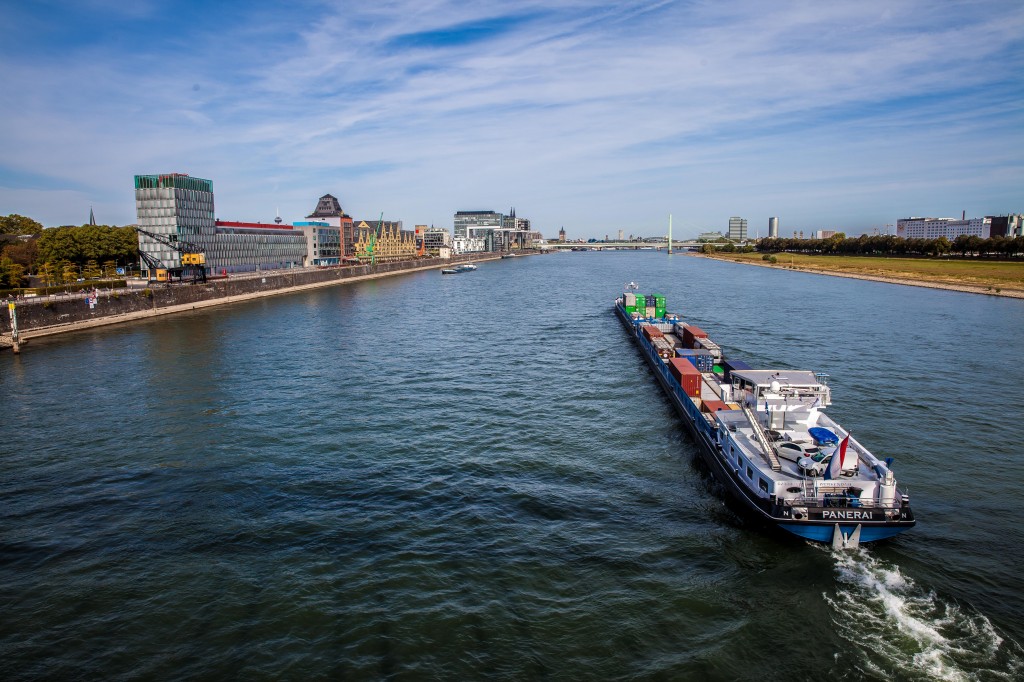 2. Rhine River. It was 76 degrees Fahrenheit on a Sunday in September, which meant the sunlight was swiftly slipping away as the winter months approach. So we walked along the Rhine, one of the major European rivers. It flows in a northerly direction, and right through Cologne.
2. Rhine River. It was 76 degrees Fahrenheit on a Sunday in September, which meant the sunlight was swiftly slipping away as the winter months approach. So we walked along the Rhine, one of the major European rivers. It flows in a northerly direction, and right through Cologne.
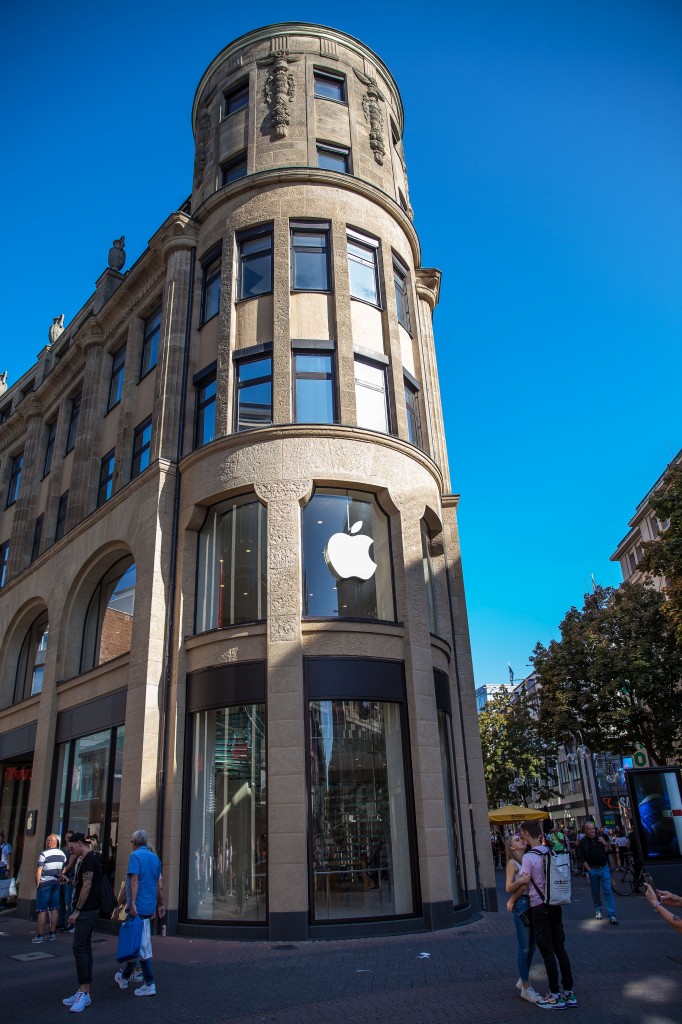 3. Shopping District. The blocks near the Cathedral are where you will find all the shopping you could want. The roads are flourishing with pedestrians, people just don’t drive there. There’s an H&M, Zara, New Yorker and even an English market. TK Maxx (it’s TK Maxx here) isn’t far either. The Apple store was not home in the modern build often seen in its U.S. stores, but housed in architecture that made its logo almost look displaced.
3. Shopping District. The blocks near the Cathedral are where you will find all the shopping you could want. The roads are flourishing with pedestrians, people just don’t drive there. There’s an H&M, Zara, New Yorker and even an English market. TK Maxx (it’s TK Maxx here) isn’t far either. The Apple store was not home in the modern build often seen in its U.S. stores, but housed in architecture that made its logo almost look displaced.
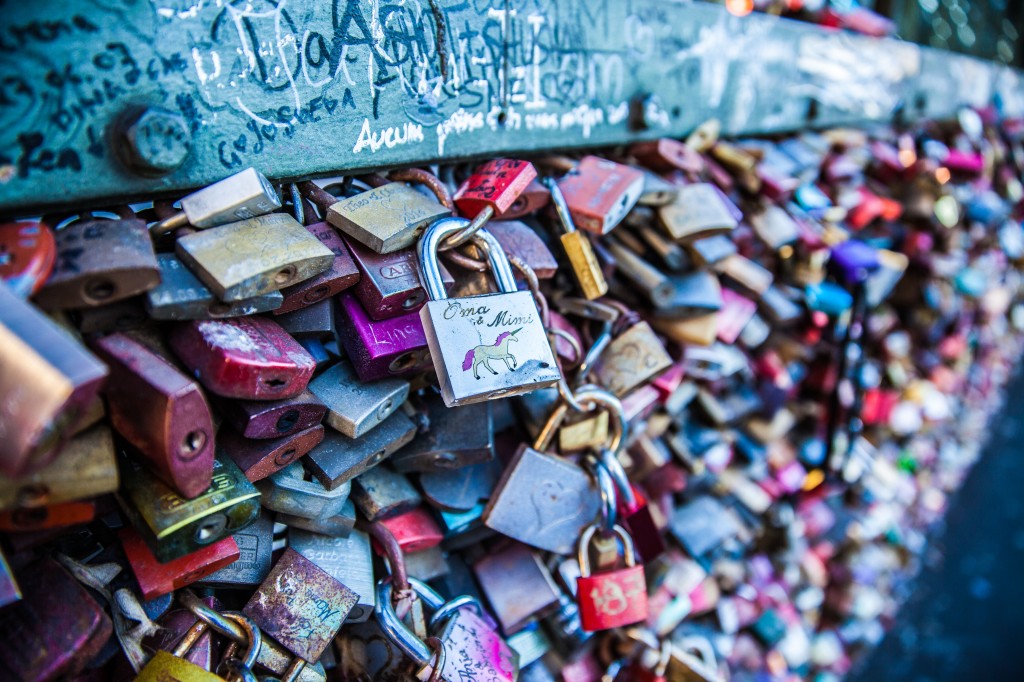 4. Love Locks. Walk across the Hohenzollern bridge and maybe even lock your own love up there! Tens of thousands of couples have pledged their love this way already, and it is truly an overwhelming amount of love to walk by if you think about it.
4. Love Locks. Walk across the Hohenzollern bridge and maybe even lock your own love up there! Tens of thousands of couples have pledged their love this way already, and it is truly an overwhelming amount of love to walk by if you think about it.
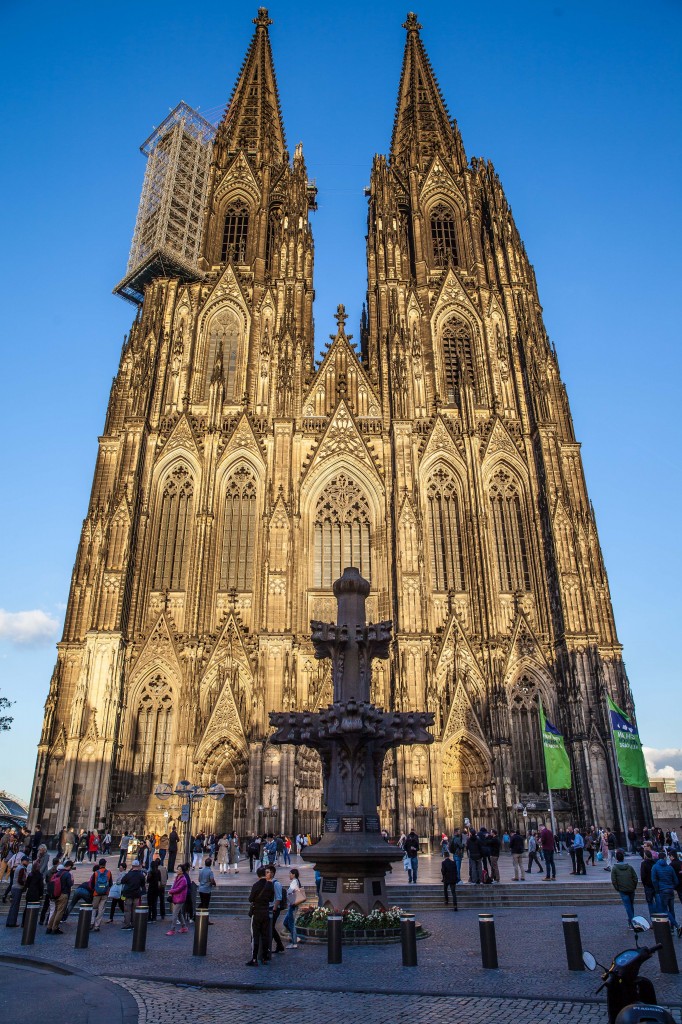 5. Cologne Cathedral. It was built to house the remains of the Three Kings (Three Wisemen) and took more than 600 years to build. The foundation was laid in 1248 and it was finally completed in 1880. For those first four years, it was the tallest building in the world.
5. Cologne Cathedral. It was built to house the remains of the Three Kings (Three Wisemen) and took more than 600 years to build. The foundation was laid in 1248 and it was finally completed in 1880. For those first four years, it was the tallest building in the world.
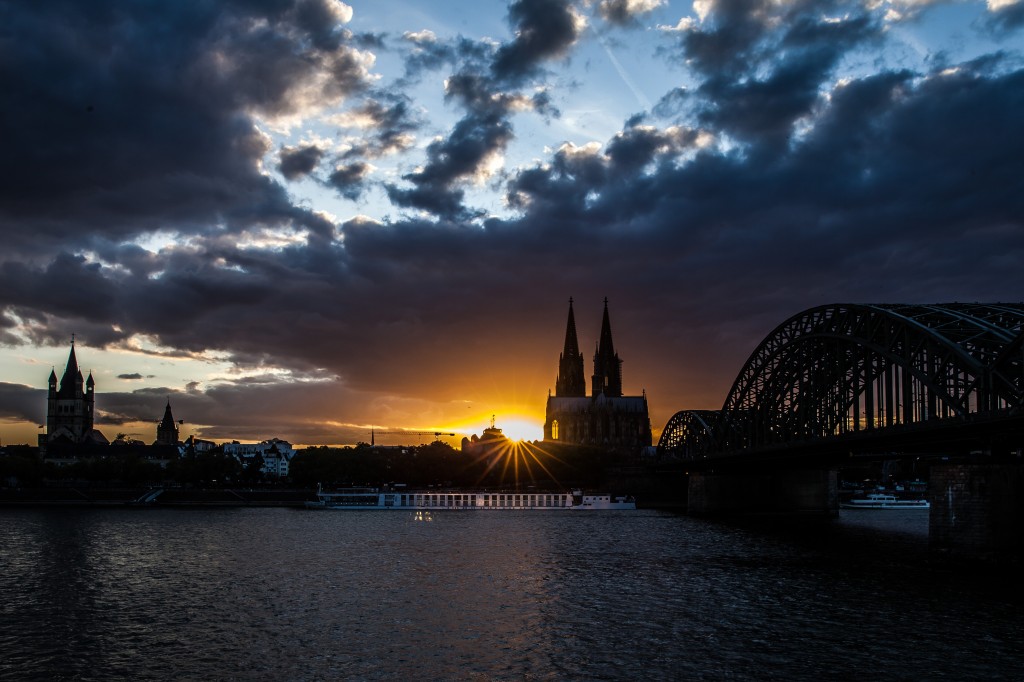 6. Sunset. With the Cologne Cathedral and the Hohenzollern Bridge, you can’t go wrong. If you stick around long enough, you may even get to see the Cathedral light up at night. I ate with my colleagues across the river at Grissini, a restaurant with walls of windows so you can’t miss the view.
6. Sunset. With the Cologne Cathedral and the Hohenzollern Bridge, you can’t go wrong. If you stick around long enough, you may even get to see the Cathedral light up at night. I ate with my colleagues across the river at Grissini, a restaurant with walls of windows so you can’t miss the view.
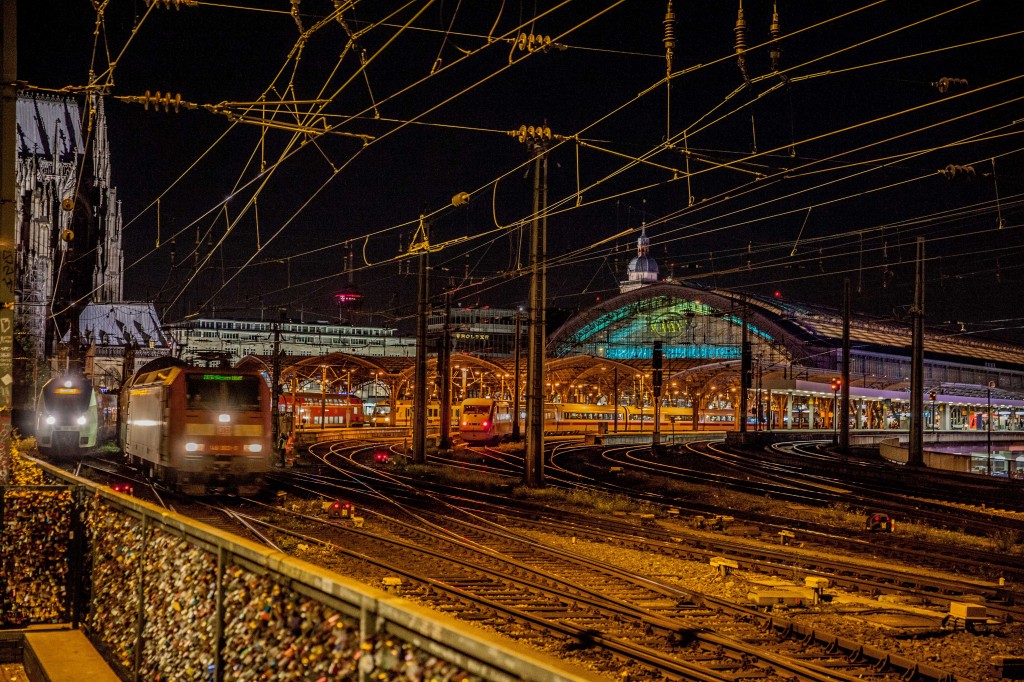 7. Nightlife. The trains run late into the night here, so whether you go out for one Kölsch, the traditional brew of Köln, or twenty (they come in small glasses for less than 2 euros a piece + your server will continuously refill your glass unless you put a coaster over it to signal you are done), you will be able to get home without operating a vehicle yourself. From art exhibits, to brew houses, to karaoke, to opera, techno, jazz and punk, there’s something special here for anyone.
7. Nightlife. The trains run late into the night here, so whether you go out for one Kölsch, the traditional brew of Köln, or twenty (they come in small glasses for less than 2 euros a piece + your server will continuously refill your glass unless you put a coaster over it to signal you are done), you will be able to get home without operating a vehicle yourself. From art exhibits, to brew houses, to karaoke, to opera, techno, jazz and punk, there’s something special here for anyone.


